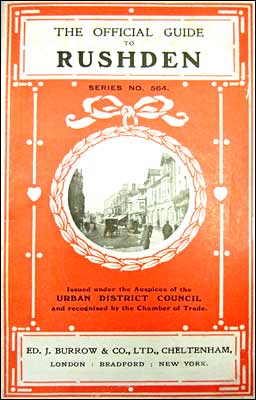 |
|
This little book is just 160 x 98mm.
|
|
Miles from London (St. Pancras), 66. Fares: 1st, 9/4; 3rd, 5/3½.
The third largest town in the administrative county, Rushden is one of the principal centres of the boot and shoe industry in Northamptonshire, and is claimed to be one of the healthiest and most prosperous towns in the Midlands. The population, which in 1881 was 3,657, rapidly increased to 7,442 in 1891, when Rushden became an Urban Authority and passed from an overgrown village to the dignity of a town. The work of the new authority was necessarily a responsible and anxious one, but was taken up in a truly progressive spirit and the Rushden of 1911, with its population of 13,354, is an improved Rushden from that of 1891.
The parish is bounded on the south and west by Bedfordshire, on the north by the borough of Higham Ferrers and the river Nene, and on the east by Newton Bromshold. Its population in 1801 was 818, in 1831, 1245, in 1841 1311, in 1851 1460, in 1861 1748, and in 1871 2122. The soil varies from a strong clay to a light sandy land, and the trustees of the late Herbert Sartoris, Esq., are the principal landed proprietors.
Enough has been said about the new frame that the present inhabitants of Rushden have constructed to meet the needs that modern life has evolved. It differs only in its completeness from the work that has been carried out with varying success in many other places in the country where increasing trade has made it necessary to attempt to introduce modern sanitation, and the comforts that ought to be found in every well-managed town. But sanitation and well-paved streets are not the only things to be considered in a complete description of a town. To limit oneself to this would be as it were to base our estimate of a man on his furniture and fortune alone. Any one thinking of investing money would wisely go further. He would seek to gauge the future prospects of the town and would enquire into the business ability of the leading manufacturers and with what success they had carried on their trade and occupation, what the regularity of employment is, and what capacity for working together in the interests of the town is shown by the inhabitants. In all these most important things a candid enquirer would find in Rushden much to satisfy himself. The staple trade is in a sound and prosperous condition. The leading businesses have been built up by men who have converted the manufacture of boots and shoes from a hand-made trade, largely carried on in the houses of the workpeople, to a great and highly-capitalized industry, centred in magnificent factories that for size and complete equipment of machinery are unequalled in the country.
Ample banking facilities are provided by two of the largest and best-managed London banks and by a local bank of high repute, under managers who are in touch with the requirements of modern commerce, and banks are now the arteries by which the surplus capital of the residential districts is brought in a fertilizing stream, to supply the needs of the manufacturing centres.
Complete stability of employment cannot, unfortunately, be attained in any trade or in any town, but the sound and carefully-managed trade of Rush-den has, even in the times of depression that seem an inevitable result of modern trade methods, hitherto been able to pass through them with less difficulty than other towns in the county. In the work of local government there are parties in Rushden as there are in all towns in which public spirit is alive, but party spirit has never stood in the way of the interests of the town; party spirit has never turned to personal bitterness, nor has it ever become a cloak to hide personal interest. In Rushden a man can hold his religious and his political opinions without fearing that he will be made to suffer in any way.
The town is blessed with an abundant supply of pure water, it has a properly constructed system of sewers, a handsome Free Library (thanks to Mr. Carnegie), commodious and convenient Public Offices, a Fire Station furnished with all modern appliances for extinguishing fire, Educational facilities of the best type, fully equipped and up-to-date factories, clean streets and good pavements, business houses where all requisites of life can be obtained without going out of town, a cheap gas supply, small holdings as required, an abundance of garden allotments, a Cottage Hospital, a Nursing Association with two district nurses, a Division of the St. John Ambulance Association and bands of music noted throughout the country.
The death-rate is small, under 10 per 1,000, no doubt partly attributable to the excellent condition under which the workers live.
Building land is plentiful and can be acquired at moderate prices in all parts of the district. Although not a garden city, everything points to Rushden as a model place in which to live and work, and it is believed that any new industry which might be established would flourish as does the shoe trade.
|
|
Situation
Rushden is situated on the main road from London to Leicester, about 63 miles north of London by road, and one-hour-and-a-half journey by rail on the Midland system. There is an excellent service of trains.
Manor
At the time of the Domesday survey, Risdene. which contained 6 hides, was a member of Higham Manor, and in the ninth year of Edward II. (1315), Richard Faber held the manor of Rushden of the Earl of Lancaster. With the Lancaster family it came to the Crown, as parcel of the Duchy of Lancaster, in the person of Henry IV. In the reign of Henry VIII., the tenants and inhabitants of Rushden and Higham obtained of Sir Thomas Cheyne the right of fishing in those lordships. The present steward holds a Court Baron annually.
It may interest some of our readers to know that much of the land in Rushden is still copyhold of the manor, of which His Majesty, as Duke of Lancaster, is lord. If they are wise enough to buy land of this tenure, possession will be delivered to them by the "rod" of which at a Manor Court they, or their solicitor, will hold one end and the steward of the manor the other. They need fear no arbitrary fines or awkward complications, for copyhold of the mancr of Rushden is Fine certain, and as easily dealt with as the ordinary freehold, from which it only differs in its old-world method of transfer. But for those who prefer the ordinary freehold title there are large building estates in convenient plots, and other properties hampered by no complications but those of the ordinary law.
Local Authority
Rushden was constituted an urban authority in the year 1891, the local governing body from that time until the passing of the Local Government Act, 1894, being known as the Local Board of Rushden. Under the latter Act an Urban Council of twelve members was formed. The Council is elected triennially.
The Council meet on the second Wednesday in each month at 7 o'clock p.m., at the Council Buildings.
|
|
Council Buildings
A commodious block of buildings at the corner of Park Road, comprising a Council chamber, together with committee rooms and a complete set of offices for the officials of the town. Built in 1906 at a cost, including site, of £3,000.
Free Library
A much appreciated institution, situate in the Newton Road, erected at a cost of £3,000, of which £2,500 was contributed by Mr. Carnegie.
The Library is managed by a committee appointed by the Urban District Council triennially.
|
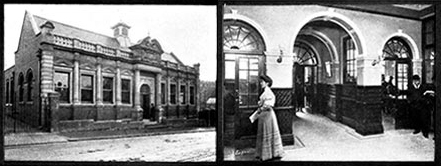 |
|
The library building and the interior
|
|
|
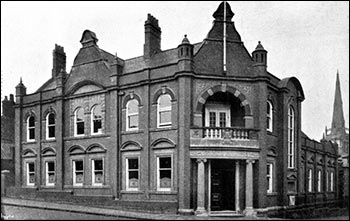 |
|
The Council Building
|
| Statistics |
|
| Population |
13,354 |
| Area |
3,775 acres |
| Rateable value, poor-rate |
£40,250 |
| Electors |
2,809 |
| Main roads, 5 miles 1¾ furlongs |
| District roads, 14 miles 5 furlongs |
| Public lamps |
222 |
|
|
Fire Station and Town Depot
These fine premises were completed in the year 1901, and cost the town £3,750. The Fire Station is equipped with two steam fire engines and all the
most modern appliances for extinguishing fire.
The Brigade consists of twelve members, who voluntarily place their services at the disposal of the town.
Electric bell connections have been fixed between the station and the houses of the firemen, and the fire station itself is on the National Telephone System.
Water Supply
The water authority is the Higham Ferrers and Rushden Water Board, consisting of nine members, three of whom are appointed by the Town Council of the borough of Higham Ferrers and six by the Rushden Urban District Council. The board was incorporated by special Act of Parliament in the year 1902, and under the powers conferred by that Acttook over the Rushden old water supply, which had proved inadequate to serve the town, and provided works for the supply of Rushden and the borough of Higham Ferrers at a cost of upwards of £100,000.
The source of supply is a drainage area of 1,747 acres around Sywell, Northants. The estimated total quantity of water available per annum is 200,750,000 gallons. The storage reservoir, situate at Sywell, has a capacity of 235,000,000 gallons, and the two service reservoirs at Rushden have capacities of 826,436 gallons and 262,500 gallons respectively. The water is pumped from Sywell to the service reservoir at Rushden, a distance of 10½ miles. The water is a good drinking water and of an exceptional degree of bacterial purity. During the prolonged drought of the summer of 1911 the storage reservoir was only sunk 16¾ inches below the overflow cill, and the smallest quantity of water ever impounded was 210,600,000 gallons.
The members of the Board are elected triennially.
They meet on the third Monday in the month at the Council Buildings, Rushden, at 7 p.m.
|
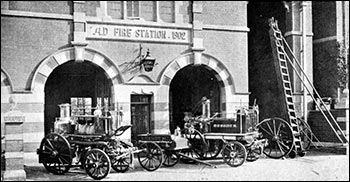 |
|
The Fire Station
|
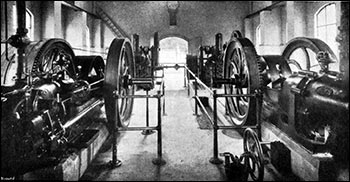 |
|
The pumping station at Sywell and reservoir (below)
|
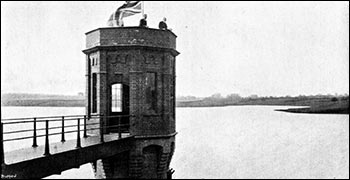 |
|
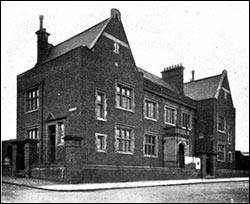 |
|
The Police Station
|
|
Police Station
The Police Station, situate in North Street, near the Midland Station, is a new building recently erected by the Northamptonshire County Council.
Gas Supply
The gas supply is in the hands of the Rushden and Higham Ferrers District Gas Company, which was incorporated by Act of Parliament in the year 1899. The capital of the Company is £40,000, divided into £20,000 original stock and £20,000 additional stock. The works, situate in the parish of Rushden, are quite modern with all the latest improvements for gas making. In 1892, when the Rushden and Higham Ferrers District Gas Company, Limited, acquired the undertakings of the Rushden and Higham Ferrers Gas Companies, the sale was 14,766,600 cubic feet and the price 4/- per 1,000 cubic feet. In 1910 the sale was 98,450,037 cubic feet and the price 2/9 per 1,000 feet, less 2d. per 1,000 discount for prompt payment. The price for motive power and public lighting is 2/6 per 1,000 cubic feet, less 2d. per 1,000 for prompt payment.
The Company is managed by a board of nine directors, of whom three retire annually.
Education
The people of Rushden are keen on education. There are the usual provided and non-provided schools in the very highest state of efficiency. For elder scholars there is an evening continuation school, in which about thirty teachers are engaged under the principal, Mr. L. Perkins, B.Sc. (London). The students number over 500 and are instructed in the following subjects—Shorthand, bookkeeping, needlework, dressmaking, cooking, etc. There are also classes for French, singing, woodwork and physical exercise. Technical classes in boot and shoe manufacture deserve special mention in regard to the number of students and successes at the examinations. Classes in art and various sciences are also well attended.
A strong local committee takes great interest in the work of these continuation classes, which are financed by the County Council, who receive in respect thereof a Government grant of upwards of £300 per annum.
The district sub-committee consists of the local members of the County Council, the members of the Provided Schools, the representative managers and one of the foundation managers of the Non-provided Schools. The managers of the provided schools are nine in number, three of whom are appointed by the Rushden Urban District Council and six by the County Education Committee.
The following is a list of the elementary schools in Rushden, with particulars of the average attendance:
|
Newton Road |
(mixed) |
496
|
|
Alfred Street |
(Boys) |
275
|
|
Alfred Street |
(Girls) |
262
|
|
Church of England |
(Mixed) |
296
|
|
North End |
(Mixed) |
360
|
|
Newton Road |
(Infants) |
343
|
|
Alfred Street |
(Infants) |
175
|
|
Moor Road |
(Infants) |
190
|
|
North End |
(Infants) |
121
|
|
Church of England |
(Infants) |
159
|
|
Rushden is peculiarly favoured with regard to the ease with which a garden allotment may be obtained, thanks to a great extent to the medium of the Rushden Permanent Allotment and Small Holdings Society, Limited, established in the year 1892.
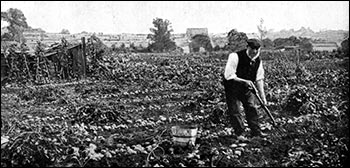 |
|
Working on his allotment
|
Allotments and Small Holdings |
|
This society has a membership of upwards of 600, who cultivate 200 acres of land, 165 acres of which are rented and 35 acres purchased; the greater portion of the latter has been sold by the society to its members. There are in addition many allotments let by private owners, and small holdings are provided by the County Council. All the allotments are conveniently situated in various parts of the town.
|
|
|
Views of the Town
|
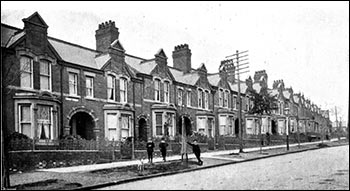 |
|
Higham Road
|
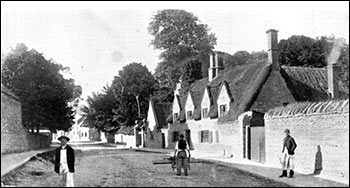 |
|
The Coach and Horses
|
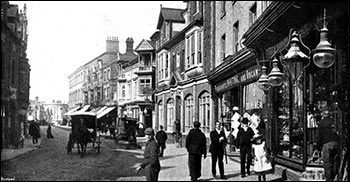 |
|
High Street - The Coffee Tavern mid-picture
|
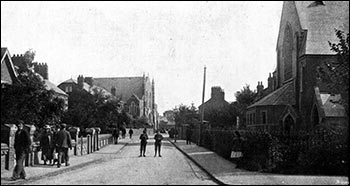 |
|
Park Road
|
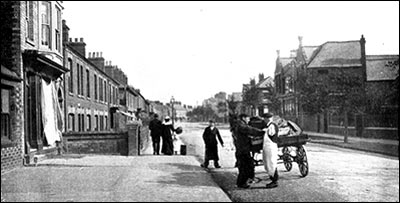 |
|
Wellingborough Road near the Oakley
|
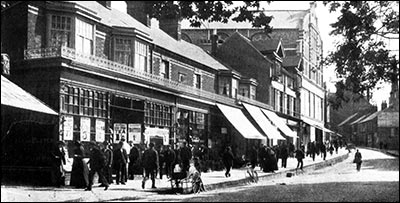 |
|
Central High Street - tall building is the Co-op Hall
|
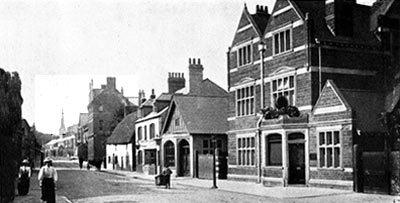 |
|
The building right was Stonehurst, third from right - the Railway Inn
|
|
|
Nursing Association
The Nursing Association is in affiliation with the Queen Victoria Jubilee Institution for Nurses, and
was started upwards of twenty years ago. Its object is to provide trained nurses to visit cases of sickness in Rushden. The association maintains two fully-qualified trained district nurses, and, with the exception of a small endowment of £4 per annum, is entirely supported by voluntary subscriptions. That the work of the association is thoroughly appreciated by the workers is testified to by the Employees Factory Fund, which last year contributed £120 towards the fund.
Cottage Hospital
This newly-formed institution is under the management and control of a Hospital Board of seven members, four of which are appointed by the Nursing Association, two by the Parochial Charity Trustees, and one by the medical men practising in the town. The hospital has an endowment of £36 per annum and receives a grant of £20 per annum from the Charity Trustees out of their general funds, otherwise it is supported by voluntary subscriptions. The hospital is situate in Griffith Street, adjoining the Nursing Home.
St. John Ambulance Brigade
The Rushden division of this brigade is strong and has newly-constructed headquarters in Station Road. There is an efficient nursing division.
|
|
Banks
The Northamptonshire Union Bank, the Capital and Counties Bank and the London City and Midland Bank all have branches in Rushden.
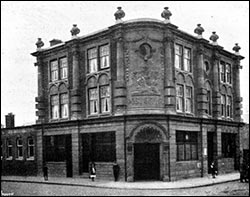 |
|
The Post Office
|
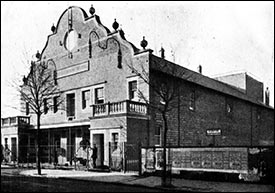 |
|
The Royal Theatre
|
|
Postal Facilities
The Central Post Office is situate in the High Street in the centre of the town, at the corner of College Street. There are sub-offices in High Street South, Newton Road, Higham Road and Wellingborough Road, and pillar boxes in convenient places in various parts of the town. There are frequent despatches and three deliveries daily.
Sports
There is a town Cricket Ground vested in trustees, and there are numerous cricket and football clubs, also tennis, bowls and angling clubs.
The Principal Cricket Clubs are the Rushden Town Cricket Club and the Rushden Thursday Cricket Club. The Rushden Fosse F.C. and the Rushden Windmill F.C. are the principal football clubs. There is an Angling Club for Rushden, Higham Ferrers and Irthlingborough.
Places of Amusement and Public Halls
The Public Hall. The Co-operative Hall. The Royal Variety Theatre. The Palace.
Clubs and Institutes
There are numerous Working Men's Clubs with substantially-built premises and large memberships, as follows:—
| The Working Men's Club, Griffith Street. |
The Trades Club, Higham Road. |
| The Athletic Club, Newton Road. |
The Town Band Club, Manton Road. |
| The Windmill Club, Windmill Road. |
The Pioneer W.M. Club, West Street. |
There is also a well-equipped Conservative Club in High Street South, which has a strong membership.
Boot Operatives' Union. The Boot Operatives' Union have a strong local branch in the district, the head offices being at the Trades Club, Higham Road.
|
The Churches
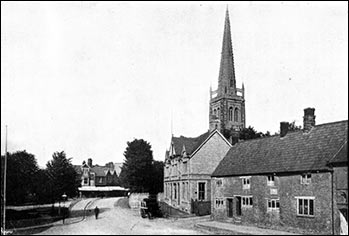 |
|
The Church and the Green
|
|
The Parish Church, dedicated to the Blessed Virgin, was formerly collegiate, and consists of a nave and side aisles, transepts, choir or chancel, north, south and west porches, an octangular turret at the north angle of the east end, and a beautifully proportioned tower in the Perpendicular style, containing a peal of six bells, and surmounted by a lofty octagonal spire with pierced crockets up the several angles. The whole is 192 feet in height. The boldness, loftiness and perfect elegance of this magnificent steeple surpasses that of Higham in the greater elegance of its taper spire, which is 96 feet high. Over the windows of the upper division of the tower is a moulding composed of a double series of trefoiled blank arches possessed of excellent Perpendicular character, above which is a battlement ornamented with pierced quatrefoils presenting a light and rich appearance. The general aspect of the interior is very striking; evidences are not wanting of there having been originally five altars in the church, the sedilia and piscina of the high altar are of singular beauty, and the reredos in the north chantry remains in good preservation, though partly hidden by a monument. The wide and lofty chancel-arch is very effective, but the most singular feature in the church, and one which immediately strikes the eye on entering, is a stone arch richly pierced with tracery which acts as a double buttress between the nave walls. Only two other examples of similar arches have been observed—at Finedon in this neighbourhood, and at Wells Cathedral. The rood screen is in good condition and there are four other screens in the church, that to the north chancel aisle having a very rich cornice. The whole fabric exhibits a mixture of the early English Decorated and Perpendicular styles. The north transept, which is the earliest part remaining, dates from about 1270, the church not having assumed its present form till about the beginning of the sixteenth century. There are some very interesting remains of stained glass. Amongst the monuments there are two to the Pemberton family, who resided in this parish for several generations. The church in 1874 went through a complete restoration at a cost of £4,500 from plans by Gordon Hills. Esq. The living is a rectory in the deanery of Higham Ferrers, rated in the King's books at £12 16s. 3d., and now worth about £400 per annum. The old Rectory House, now the residence of Fred Knight, Esq., J.P., was sold in 1869 and a commodious one was built by the then rector, the Rev. John T. Barker. M.A., a little to the north of the church, in the years 1870 and 1871. The tithes were commuted for land in 1778.
St. Peter's Church. This is a new church erected at the north end of the town, which will provide accommodation for about 500 worshippers.
Park Road Baptist Church. This church is a handsome building of the late Gothic style, it provides accommodation for over 1,000 worshippers. The corner stones were laid on September 24th, 1900, and the new church was opened on Feast Monday, September 23rd, 1901. The cost of erection of this church was about £6,500, the whole of which amount has been voluntarily subscribed. The church takes the place of the old "Top Meeting", a building which will be always famous in the history of Rushden and in connection with which the name of the late Rev. Robert E. Bradfield will ever be associated.
Independent Wesleyan Church. This church is situate in the High Street, was opened in February, 1900; has seating accommodation for 750 worshippers and cost about £2,500. There are commodious school-rooms in Queen Street adjoining, erected in 1890 at a cost of nearly £2,000.
Wesleyan Church. The Wesleyan Church is situated in Park Road, is a new building and provides accommodation for 750 worshippers, and cost in erection upwards of £5,COO. The building was opened on Easter Monday, 1905. The church is in the Higham Ferrers Wesleyan Circuit.
Independent Wesleyan Mission Hall. This hall is situate on the Wellingborough Road, was opened in July, 1901, and will accommodate 450 persons, and cost about £2,500.
Succoth Baptist Church, one of the older churches in the town, occupies a prominent position in the High Street and has seating accommodation for about 300 worshippers.
Congregational Church. The Congregational Church in Church Street was opened in June, 1894, under the ministry of the late Rev. M. E. Parkin. It accommodates about SCO worshippers.
Primitive Methodist Church is situate in Fitz-william Street, has accommodation for 150 persons. The church was opened in February, 1890.
Catholic Church. The Catholic Church is situate at the corner of the Hayway and consists of a small temporary church, erected at the end of 1904, and a Presbytery. The Rev. Father Waldie was the priest in charge until his death.
Salvation Army. The Salvation Army have barracks in Queen Street, and the Plymouth Brethren have a small meeting place in Moor Road.
Rushden Hall
Rushden Hall, the seat of Mrs. F. U. Sartoris, is situate near the centre of the town on an elevation surrounded by fine plantations, gardens and pleasure grounds. The house is quadrangular and principally consists of a retreating centre and two projecting wings. On the south side is a square-embattled tower, presenting much the appearance of a castellated edifice. This mansion once possessed one of the finest old halls in the county, but it has of late years been incorporated with other apartments and thus entirely swept away. Norden tells us that "there was in Rushden an ancient house of the Dukes of Lancaster". This house is supposed to have been built by the renowned John of Gaunt. Duke of Lancaster, and upon its site the present mansion in the Elizabethan style has been erected.
Charities
The following are particulars of the Parochial Charities :—
Mayes. A close of land situate in the parish of Wollaston, containing about 10 acres in the occupa-of Mr. Amos Smart, at an annual rental of £20.
Lathams. An annual payment of £3 issuing out of real property in the parish of Barnwell.
Greaves or Bull Money. An annual payment of £3 formerly issuing out of lands in the parish of Rushden, the property of the late Mr. Thomas Sanders, and redeemed by his executors in the year 1905 by the transfer of £120 consols, to the official trustees of Charitable Funds in trust for the charity.
Wllkins-Foskett. £100 £4 per cent mortgage debentures in the Rushden and Higham Ferrers District Gas Company, the income of which is directed to be paid to the Rushden Nursing Association.
|
6 £50 Rushden & Higham Ferrers District Gas Co. £4 per cent. Mortgages |
£300 0 0
|
|
£480 Rushden & Higham Ferrers District Gas Co. Original Stock |
1056 0 0
|
|
£24 Rushden & Higham Ferrers District Gas Co. Additional Stock |
36 0 0
|
|
Cash |
531 16 4
|
|
|
£1923 16 4
|
Subject to prior life interests and the payment thereout of £400 to the Park Road Baptist Church, the above funds were bequeathed by the late Mr. William Henry Wilkins to the Parochial Trustees for the endowment of a Cottage Hospital for Rushden. One life tenant is dead, £200 has been paid to the Park Road Baptist Church, and one-half of the funds has been transferred to the Official Trustees of Charitable Funds.
The late Miss Susan Elizabeth Foskett left a legacy of £50 in augmentation of the funds of the last-mentioned charity, which sum has also been paid over to the Official Trustees of Charitable Funds for investment.
The whole of the annual income accruing from the parochial charities, so far as it is not otherwise by the trust deeds specifically allocated, is now being applied towards the maintenance and support of a Cottage Hospital in Rushden.
The charities are administered by a board known as the Parochial Charity Trustees, consisting of the Rector and Churchwardens and six members appointed by the Rushden Urban District Council.
Musical
Rushden is renowned for its musical talent, and chief amongst the many musical organizations is the Rushden Temperance Band, which has won, in the course of its history, prizes to the value of upwards of £1500.
The Rifle Prize Band has also taken a prominent position in the musical world under the leadership of Mr. E. Whitworth. The Park Road Baptist Church Choir, who has attained successes at the Crystal Palace and at Northampton, has also added musical fame to the town. There are also the Park Road Wesleyan Church Choir and the Adult School Male Choir, which have gained prizes.
Our Neighbours
Busy manufacturing towns are often in districts that have little to offer to the private resident unconnected with trade. Rushden has developed from a village into a town within the memory of many still living in it; and round it still lie villages untouched by the growth of industrialism.
The ancient and historic borough of Higham Ferrers joins the northern boundary of the parish and brings to the mind the contrast between the England of Henry V. with its dominant prelate, Henry Chicheley, Archbishop of Canterbury, and our own time, dominated by other lords and other forces, In Higham Ferrers the school that he founded, a graceful fifteenth century building, is well worth a visit. It stands in a churchyard surrounded by old houses that only lack size to fit them for the habitation of canons and a dean. There is a Bede House and an ancient vicarage, a subtile architectural composition completed by a tower and a spire beloved by the great leaders of the Gothic revival that followed on the romantic movement of the early part of the nineteenth century. The fine gateway of the old college of priests stands in the High Street of the same town and in what is called the Castle Field, is the old moat connected with the Castle of the Dukes of Lancaster.
At the little village of Wymington, which lies a mile or two to the south-west of Rushden, is one of those rare mediaeval churches built to a complete and perfect design and it has happily survived almost untouched by the hand of the restorer. In it is a magnificent brass, and more interesting still, oak benches black and shining with age, at the end of which are draw-out ends for the overflow of the congregation.
There are fine churches at Newton Bromshold, Yelden and Podington—all within easy walking distance. The country round is pleasantly wooded and well watered.
Castle Ashby, a seat of the Marquess of Northampton, is within a driving distance, and a description of it is given in the "Borough" Guide to Northampton.
Motorists will find excellent accommodation at the hotels and other establishments in the town. They will find roads in fine order and the county police by no means anxious to stretch antiquated laws to the inconvenience of any one who is willing, as most motorists now are, to drive with due regard to the interests of other users of the roads.
No one can know England who does not know the Midlands thoroughly, and the country lying round Rushden is as satisfying as anyone who can appreciate the quiet beauty of the real English landscape can desire.
|
|

















